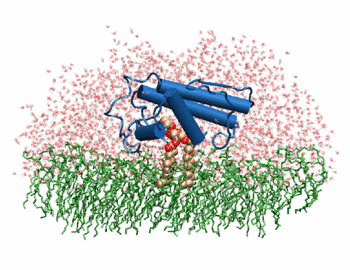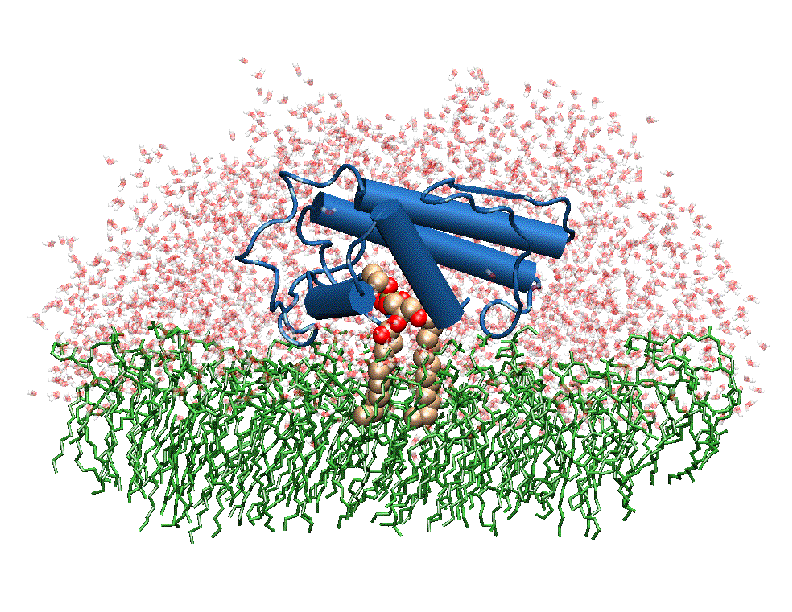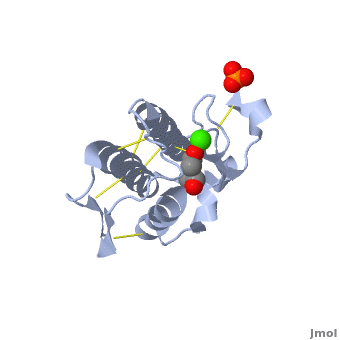Function
Phospholipase A2 (PLA2) is an enzyme which releases fatty acids from glycerol. It is found in mammals and in snake venoms[1]. PLA2 releases arachidonic acid from membranes causing inflammation and pain. The PLA2 contains many isozymes which are ordered by groups and named accordingly, ie., group I is PLA2G1.
- PLA2 group II is induced in inflammation and present in atherosclerotic lesions[2].
- PLA2 group V is active in leukocytes recruitment[3].
- PLA2 group X regulates cysteinyl leukotriene synthesis[4].
- PLA2 group XV is located in the endocytic system and may be involved in CD1d function[5].
- PLA2 group XVI is adipose-specific[6].
- Lipoprotein-associated phospholipase A2 or platelet-activating factor acetylhydrolase (Lp-PLA2) degrades platelet-activating factor and oxidized phospholipids into inactive metabolites. Platelet-activating factor is a potent phospholipid activator and mediator of inflammation, platelet aggregation and other leukocyte functions[7].
.
- Bothropstoxin (BTX) is PLA2 from the snake Bothrops jararacussu.
- Piratoxin (PTX) is PLA2 from the snake Bothrops piraña.
- Viperotoxin (VTX) is a heterodimer of a very homologous PLA2 called RV-4/RV-7.
- Cystolic PLA2 (cPLA2) is intracellular. It is larger than the secreted PLA2 and contains the targeting C2 domain.
- Pro-phosphlipase (PPLA2) is a pancreatic PLA2 whose 7-mer N-terminal peptide is cleaved off to produce the active PLA2.
- For details on Lys49 snake-venom PLA2 see Anum-II.
- See also Phospholipase (Hebrew).
Relevance
PLA2 serve as pharmacological targets for therapeutical treatment of diseases like atherosclerosis, immune disorders, cardiovascular diseases and cancer[8]. Reduced Lp-PLA2 activity is observed in patients with severe sepsis. There is association between the level of Lp-PLA2 in plasma and the risk of future cardiovascular events[9].
Diclofenac binding to Phospholipase A2[10]
Abstract from Pubmed
Type IIA secretory phospholipase A2 (PLA2) enzymes catalyze the hydrolysis of the sn-2 ester bond of glycerophospholipids to release fatty acids and lysophospholipids. In order to elucidate the role of PLA2 in inflammatory disorders and to determine the mode of binding of non-steroidal anti-inflammatory drugs (NSAIDs) to PLA2, the detailed three-dimensional structure of a complex formed between a group IIA PLA2 from Daboia russelli pulchella and 2-[(2,6-dichlorophenyl)amino]benzeneacetic acid (diclofenac) has been determined. The preformed complex was crystallized by equilibrating the protein solution against a mixture of 0.20 M ammonium sulfate and 30% PEG 4000. The crystals belong to space group P4(3), with unit-cell parameters a = b = 53.0, c = 48.4 A. The structure was solved by the molecular-replacement method and refined to R(cryst) and R(free) factors of 0.192 and 0.211, respectively, using reflections to 2.7 A resolution. The structure showed that diclofenac occupies a very favourable position in the centre of the substrate-binding hydrophobic channel that allows a number of intermolecular interactions. The binding mode of diclofenac involved crucial interactions with important residues for substrate recognition such as Asp49, His48 and Gly30. In addition, it included three new interactions involving its Cl atoms with Phe5, Ala18 and Tyr22. It also showed an extensive network of hydrophobic interactions involving almost all of the residues of the substrate-binding hydrophobic channel. The binding affinity of diclofenac was determined using surface plasmon resonance, which gave an equilibrium constant of 4.8 +/- 0.2 x 10(-8) M.
The
shows three mail helices in phospholipase A2.
The are His 48, Asp 49, Tyr 52 and Glu 99 in the structure.
Diclofenac makes several with the substrate binding site of enzyme. ligand binding is shown in model of the complex. See also Diclofenac.
Crystal structure of porcine pancreatic phospholipase A2 in complex with 2-methoxycyclohexa-2-5-diene-1,4-dione
[11]
possesses anti-inflammatory activity. The binding of curcumin with PLA2 was studied using X-ray crystallography. Since the electron density found in the active site did not match with curcumin, (the photo-degraded product of curcumin) in the unexplained electron density. To understand the , molecular docking studies was carried out. with respect to the ligand position and identified that of PLA2 with a binding energy -16.81 Kcal/mol. The binding mode is in such a manner that it can prevent the entry of substrate to the hydrophobic active site. These studies indicate that curcumin can be act as an inhibitor to PLA2.
Interaction of Atropine with Phospholipase A2
(1th6).

Phospholipase 2A in complex with cell membrane
In addition to its ability to form complexes with acetylcholine receptors, atropine can also complex with phospholipase A2. Phospholipase A2 is a category of heat-stable enzymes which are involved in cell signaling processes, such as the inflammatory response. [12]. Phospholipase 2A is an upstream regulator of inflammatory processes, and more specifically, it recognizes the sn-2 acyl bond of phospholipids and catalytically hydrolyzes the bond, releasing lysophospholipids [13].
This protein is found in mammals, reptile venom, and bacteria. In humans, the overproduction of phospholipase A2 leads to neurologic disorders such as schizophrenia and possibly autism [14]. An inhibitor of Phospholipase A2, such as Atropine, could be used to treat disorders associated with neural trauma, since Phospholipase A2 increases inflammation which could be potentially complicate neural trauma cases [15].
The image to the above shows the membrane-bound phospholipase A2 in blue [16].
Atropine in the Active Site of Phospholipase A2
Atropine is an inhibitor of phospholipase 2A, and can be seen in complex with this enzyme on the left. The can be seen more clearly in gray using the ball-and stick representation of the drug and protein. It can also be seen in green in this , where protein appears in brown, ligands appear in green, and solvents appear in blue. Finally, the
portions of the protein can be highlighted from blue to red in a rainbow, and the active site with atropine can be seen in the middle of the protein.
Atropine interacts with phospholipase 2A at residues asp29 and tyr49 on the protein. The
of atropine interacting with phospholipase 2A can be seen on the right. The amino acid residues in the active site are labeled. As seen in the acetylcholine receptor, the regions of the phospholipase 2A enzyme are found in the active site, which is where the atropine binds and inhibits the enzyme. The hydrophobic regions, represented in gray, can be seen surrounding atropine, which is positioned in the active site and capped by red oxygen atoms.
Removing the labels, atropine can be seen making contact with the atoms emphasized by the space filling model, interacting with the of phospholipase 2A through white as-tricks.
3D Structures of Phospholipase A2
Phospholipase A2 3D structures



